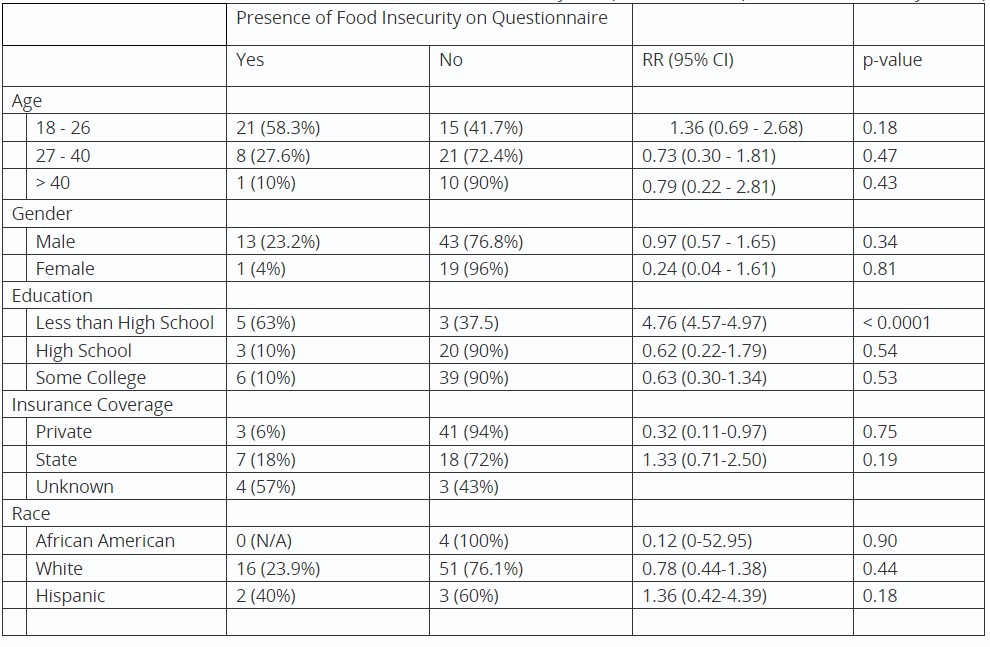Oral Paper Presentation
Annual Scientific Meeting
Session: Plenary Session 4A - Biliary / Pancreas / Interventional Endoscopy
62 - Socioeconomic Factors Associated with Risk of Food Insecurity in the Adult Cystic Fibrosis Population: A Prospective Analysis
Wednesday, October 25, 2023
9:40 AM - 9:50 AM PT
Location: Ballroom A

Eugene Nwankwo, MD
Saint Louis University Hospital
St. Louis, MO
Presenting Author(s)
Maya Mahmoud, MD1, Eugene Nwankwo, MD2, Aaron Goffinet, 3, Ameya Deshmukh, DO2, Eyad Gharaibeh, MD1, Abdallah El Alayli, MD1, Ravi Nayak, MD1, Christopher Barrios, MD1, Christine Hachem, MD1
1Saint Louis University, St. Louis, MO; 2Saint Louis University Hospital, St. Louis, MO; 3Saint Louis School of Medicine, St. Louis, MO
Introduction: Food insecurity (FI) rates among people with cystic fibrosis (CF) are significantly higher than in the general US population. Prior literature has elucidated the impact of social determinants of health and FI on the pediatric CF population, but little research exists exploring such factors and their risk for FI in the adult CF population.
Methods: We performed a prospective survey of adult CF patients seen at the Gastroenterology and Pulmonary outpatient clinics at SSM Saint Louis University between July and November 2022. Age of the cohorts was classified into early, middle and late adulthood. Demographic and clinical data was collected from patient’s charts. Surveys were conducted using the 2-item food security screening tool to evaluate the risk of food insecurity created and validated by the United States Department of Agriculture (USDA) and National Institutes of Health (NIH).
Results: We identified 76 adults with CF with a median age of 25 years (range 18-61). GI manifestations were present in 74 (97%) patients with the most common GI disorder being pancreatic insufficiency (88%), followed by gastroesophageal reflux disease (GERD) (62%). CF liver disease (CFLD) was seen in 17 (16%), 32 (42%) patients had CF related diabetes (CFRD) and 41 (54%) were diagnosed with malnutrition. 30 (39.5%) patients with CF reported significant challenges with food access in the past year. Young adults aged 18 to 26 years old (58.3%) experienced more FI than older ones (RR 1.36, 0.69 - 2.68, p= 0.18). 23.2% of male patients had a higher risk for FI compared to 4% of women (RR 0.97, p= 0.34). 18% of CF patients with a public form of insurance coverage (Medicaid, or Medicare) reported FI compared to 6% for private insurance. Further, 63% of CF patients who reported having less than a high school level of education were most likely to be affected by FI compared to the general population (RR 4.76, p < 0.0001). Based on race, 40% of Hispanic patients reported FI compared to 12% of White patients. No black patients reported significant FI in this cohort. Results are shown in Table 1.
Discussion: In this small cohort, almost 40% of our cohort suffers from FI. Low education level, age < 26 years, and Hispanic ethnicity predicted a significant risk of food insecurity in adults with CF. Now that CF patients are more likely to live well into adulthood, adult patients with disparities in educational level, and other social determinants of health are likely to experience FI and poor access to healthy food options.

Disclosures:
Maya Mahmoud, MD1, Eugene Nwankwo, MD2, Aaron Goffinet, 3, Ameya Deshmukh, DO2, Eyad Gharaibeh, MD1, Abdallah El Alayli, MD1, Ravi Nayak, MD1, Christopher Barrios, MD1, Christine Hachem, MD1, 62, Socioeconomic Factors Associated with Risk of Food Insecurity in the Adult Cystic Fibrosis Population: A Prospective Analysis, ACG 2023 Annual Scientific Meeting Abstracts. Vancouver, BC, Canada: American College of Gastroenterology.
1Saint Louis University, St. Louis, MO; 2Saint Louis University Hospital, St. Louis, MO; 3Saint Louis School of Medicine, St. Louis, MO
Introduction: Food insecurity (FI) rates among people with cystic fibrosis (CF) are significantly higher than in the general US population. Prior literature has elucidated the impact of social determinants of health and FI on the pediatric CF population, but little research exists exploring such factors and their risk for FI in the adult CF population.
Methods: We performed a prospective survey of adult CF patients seen at the Gastroenterology and Pulmonary outpatient clinics at SSM Saint Louis University between July and November 2022. Age of the cohorts was classified into early, middle and late adulthood. Demographic and clinical data was collected from patient’s charts. Surveys were conducted using the 2-item food security screening tool to evaluate the risk of food insecurity created and validated by the United States Department of Agriculture (USDA) and National Institutes of Health (NIH).
Results: We identified 76 adults with CF with a median age of 25 years (range 18-61). GI manifestations were present in 74 (97%) patients with the most common GI disorder being pancreatic insufficiency (88%), followed by gastroesophageal reflux disease (GERD) (62%). CF liver disease (CFLD) was seen in 17 (16%), 32 (42%) patients had CF related diabetes (CFRD) and 41 (54%) were diagnosed with malnutrition. 30 (39.5%) patients with CF reported significant challenges with food access in the past year. Young adults aged 18 to 26 years old (58.3%) experienced more FI than older ones (RR 1.36, 0.69 - 2.68, p= 0.18). 23.2% of male patients had a higher risk for FI compared to 4% of women (RR 0.97, p= 0.34). 18% of CF patients with a public form of insurance coverage (Medicaid, or Medicare) reported FI compared to 6% for private insurance. Further, 63% of CF patients who reported having less than a high school level of education were most likely to be affected by FI compared to the general population (RR 4.76, p < 0.0001). Based on race, 40% of Hispanic patients reported FI compared to 12% of White patients. No black patients reported significant FI in this cohort. Results are shown in Table 1.
Discussion: In this small cohort, almost 40% of our cohort suffers from FI. Low education level, age < 26 years, and Hispanic ethnicity predicted a significant risk of food insecurity in adults with CF. Now that CF patients are more likely to live well into adulthood, adult patients with disparities in educational level, and other social determinants of health are likely to experience FI and poor access to healthy food options.

Table: Table 1. Risk of food insecurity among CF patients based on demographics and social determinants of health
Disclosures:
Maya Mahmoud indicated no relevant financial relationships.
Eugene Nwankwo indicated no relevant financial relationships.
Aaron Goffinet indicated no relevant financial relationships.
Ameya Deshmukh indicated no relevant financial relationships.
Eyad Gharaibeh indicated no relevant financial relationships.
Abdallah El Alayli indicated no relevant financial relationships.
Ravi Nayak indicated no relevant financial relationships.
Christopher Barrios indicated no relevant financial relationships.
Christine Hachem indicated no relevant financial relationships.
Maya Mahmoud, MD1, Eugene Nwankwo, MD2, Aaron Goffinet, 3, Ameya Deshmukh, DO2, Eyad Gharaibeh, MD1, Abdallah El Alayli, MD1, Ravi Nayak, MD1, Christopher Barrios, MD1, Christine Hachem, MD1, 62, Socioeconomic Factors Associated with Risk of Food Insecurity in the Adult Cystic Fibrosis Population: A Prospective Analysis, ACG 2023 Annual Scientific Meeting Abstracts. Vancouver, BC, Canada: American College of Gastroenterology.
